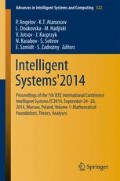Abstract
The framework of Approximate Tolerance Geometry (ATG) has been proposed in [1] as an approach to handling large and heterogeneous imperfections in geometric data in vector-based geographic information systems. Here, different types of positional error can often only be subsumed as possibilistic location constraints. The application of the ATG framework to a classical geometry provides a calculus for the propagation of this error type in geometric reasoning. As a first step towards an implementation of an ATG geometry, the paper applies the framework to the geometric equality relation. It thereby lays the basis for the application of ATG to the other axioms of classical geometry.
Access this chapter
Tax calculation will be finalised at checkout
Purchases are for personal use only
Preview
Unable to display preview. Download preview PDF.
References
Wilke, G.: Fuzzy logic with evaluated syntax for sound geometric reasoning with geographic information. In: Proceedings of the Annual Meeting of the North American Fuzzy Information Processing Society, NAFIPS 2014 (2014)
Goodchild, M.F.: Citizens as voluntary sensors: Spatial data infrastructure in the world of web 2.0. International Journal of Spatial Data Infrastructures Research 2, 24–32 (2007)
Wilke, G.: Towards approximate tolerance geometry for gis - a framework for formalizing sound geometric reasoning under positional tolerance. Ph.D. dissertation, Vienna University of Technology (2012)
Pullar, D.V.: Consequences of using a tolerance paradigm in spatial overlay. In: Proceedings of the Auto-Carto 11, pp. 288–296 (1993)
Novak, V., Perfilieva, I., Mockor, J.: Mathematical Principles of Fuzzy Logic. Kluwer Academic Publishers (1999)
Gerla, G.: Fuzzy Logic - Mathematical Tools for Approximate Reasoning. In: Trends in Logic, vol. 11. Kluwer Acadeic Publishers (2001)
Gerla, G.: Approximate similarities and poincare paradox. Notre Dame Journal of Formal Logic 49(2), 203–226 (2008)
Perkal, J.: On epsilon length. Bulletin de l’Academie Polonaise des Sciences 4, 399–403 (1956)
Shi, W.: A generic statistical approach for modelling error of geometric features in gis. International Journal of Geographical Information Science 12(2), 131–143 (1998)
Buyong, T.B., Frank, A.U., Kuhn, W.: A conceptual model of measurement-based multipurpose cadastral systems. Journal of the Urban and Regional Information Systems Association URISA 3(2), 35–49 (1991)
Shi, W., Cheung, C.K., Zhu, C.: Modelling error propagation in vector-based buffer analysis. International Journal of Geographical Information Science 17(3), 251–271 (2003)
Leung, Y., Ma, J.-H., Goodchild, M.F.: A general framework for error analysis in measurement-based gis, parts 1-4. Journal of Geographical Systems 6(4), 323–428 (2004)
Dougenik, J.A.: Whirlpool: A geometric processor for polygon coverage data. In: Proceddings AUTOCARTO, vol. 4, pp. 304–311 (1979)
Beard, K.M.: Zipping: New software for merging map sheets. In: Proceedings of the American Congress on Surveying and Mapping, vol. 1, pp. 153–161 (1986)
Chrisman, N.R.: The accuracy of map overlays: A reassessment. In: Landscape and Urban Planning, vol. 14, pp. 427–439 (1987), http://www.sciencedirect.com/science/article/B6V91-46MN01M-1X/2/297d236facc206cdf028eedd653eb36d
Beard, K.M., Chrisman, N.R.: Zipper: A localized approach to edgematching. Cartography and Geographic Information Science 15(2), 163–172 (1988)
Chrisman, N., Dougenik, J.A., White, D.: Lessons for the design of polygon overlay processing from the odyssey whirlpool algorithm. In: Bresnahan, P., Corwin, E., Cowen, D. (eds.) Proceedings of the 5th International Symposium on Spatial Data Handling, vol. 2, pp. 401–410. IGU Commission of GIS (1992)
Zhang, G., Tulip, J.: An algorithm for the avoidance of sliver polygons and clusters of points in spatial overlay. In: Proceedings of the 4th Inthernational Symposium on Spatial Data Handling (1990)
Harvey, F., Vauglin, F.: Geometric match processing: Applying multiple tolerances. In: Proceedings of 7th International Symposium on Spatial Data Handling (1996)
Abdelmoty, A.I., Jones, C.B.: Towards maintaining consistency of spatial databases. In: Proceedings of the Sixth International Conference on Information and Knowledge Management, CIKM 1997, pp. 293–300. ACM, New York (1997), http://doi.acm.org/10.1145/266714.266913
Clementini, E.: A model for uncertain lines. Journal of Visual Languages & Computing 16(4), 271–288 (2005)
Salesin, D., Stolfi, J., Guibas, L.: Epsilon geometry: building robust algorithms from imprecise computations. In: SCG 1989: Proceedings of the Fifth Annual Symposium on Computational Geometry, pp. 208–217. ACM, New York (1989)
Veregin, H.: Data quality parameters. In: Longley, P.A., Goodchild, M.F., Maguire, D.J., Rhind, D.W. (eds.) Geographical Information Systems, 2nd edn., vol. 1&2, pp. 177–189. John Wiley & Sons (1999)
Roberts, F.S.: Tolerance geometry. NDJFAM 14(1), 68–76 (1973)
Katz, M.: Inexact geometry. Notre Dame Journal of Formal Logic 21(3), 521–535 (1980)
Hájek, P.: Fuzzy logic. In: Zalta, E.N. (ed.) The Stanford Encyclopedia of Philosophy, Fall 2010 edn. (2010), http://plato.stanford.edu/archives/fall2010/entries/logic-fuzzy/
Godo, L., Rodriguez, R.O.: Logical approaches to fuzzy similarity-based reasoning: an overview, vol. 504, pp. 75–128. Springer (2008)
Wilke, G., Frank, A.: On equality of lines with positional uncertainty. In: Proceedings of the Sixth International Conference on Geomgraphic Information Science (2010)
Wilke, G., Frank, A.: Tolerance geometry - euclids first postulate for points and lines with extension. In: Proceedings of the ACM SIGSPATIAL 2010, San Jose, California, USA (2010)
Author information
Authors and Affiliations
Corresponding author
Editor information
Editors and Affiliations
Rights and permissions
Copyright information
© 2015 Springer International Publishing Switzerland
About this paper
Cite this paper
Wilke, G. (2015). Equality in Approximate Tolerance Geometry. In: Angelov, P., et al. Intelligent Systems'2014. Advances in Intelligent Systems and Computing, vol 322. Springer, Cham. https://doi.org/10.1007/978-3-319-11313-5_33
Download citation
DOI: https://doi.org/10.1007/978-3-319-11313-5_33
Publisher Name: Springer, Cham
Print ISBN: 978-3-319-11312-8
Online ISBN: 978-3-319-11313-5
eBook Packages: EngineeringEngineering (R0)

